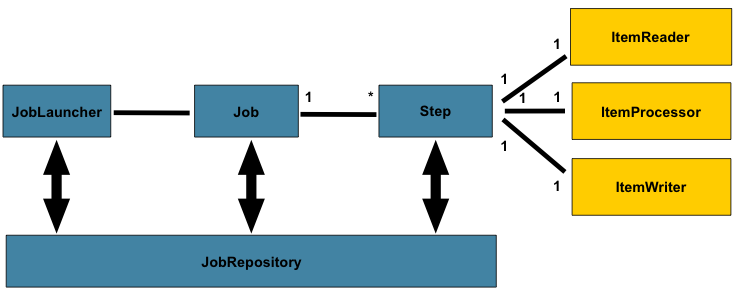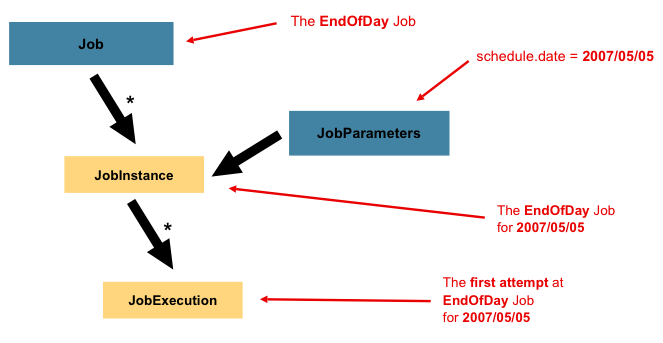Spring Batch 是一个轻量级的、完善的批处理框架,旨在帮助企业建立健壮、高效的批处理应用。Spring Batch是Spring的一个子项目,使用Java语言并基于Spring框架为基础开发,使得已经使用 Spring 框架的开发者或者企业更容易访问和利用企业服务。
Spring Batch 提供了大量可重用的组件,包括了日志、追踪、事务、任务作业统计、任务重启、跳过、重复、资源管理。对于大数据量和高性能的批处理任务,Spring Batch 同样提供了高级功能和特性来支持,比如分区功能、远程功能。总之,通过 Spring Batch 能够支持简单的、复杂的和大数据量的批处理作业。
Spring Batch 是一个批处理应用框架,不是调度框架,但需要和调度框架合作来构建完成的批处理任务。它只关注批处理任务相关的问题,如事务、并发、监控、执行等,并不提供相应的调度功能。如果需要使用调用框架,在商业软件和开源软件中已经有很多优秀的企业级调度框架(如 Quartz、Tivoli、Control-M、Cron 等)可以使用。
1.现在实现Spring Batch方法,首先是配置:
@Configuration
@EnableBatchProcessing
public class SpringBatchConfiguration {
@Resource
private DataSource dataSource;
@Resource
private PlatformTransactionManager transactionManager;
/**
* 任务仓库
* @return
*/
@Bean
public JobRepository jobRepository() throws Exception{
JobRepositoryFactoryBean jobRepositoryFactoryBean = new JobRepositoryFactoryBean();
jobRepositoryFactoryBean.setTransactionManager(transactionManager);
jobRepositoryFactoryBean.setDataSource(dataSource);
jobRepositoryFactoryBean.setDatabaseType("mysql");
return jobRepositoryFactoryBean.getObject();
}
/**
* 任务加载器
* @return
*/
@Bean
public SimpleJobLauncher jobLauncher() throws Exception{
SimpleJobLauncher launcher = new SimpleJobLauncher();
launcher.setJobRepository(this.jobRepository());
return launcher;
}
@Bean
public TestJobListener testJobListener(){
return new TestJobListener();
}
}
2.TestJobListener监听器
public class TestJobListener implements JobExecutionListener {
private final Logger logger = Logger.getLogger(this.getClass().getName());
private long time = 0L;
@Override
public void beforeJob(JobExecution jobExecution) {
this.time = System.currentTimeMillis();
logger.info(">>job start");
}
@Override
public void afterJob(JobExecution jobExecution) {
logger.info(">>job end("+(System.currentTimeMillis()-time)+")");
}
}
3.读操作代码
public class TestItemReader2 extends FlatFileItemReader<BikeKey> { public TestItemReader2(){ } public void setData(String path,LineMapper<BikeKey> lineMapper){ this.setResource(new FileSystemResource(path)); this.setLineMapper(lineMapper); } } //LineMapper代码@Component public class TestItemLineMapper implements LineMapper<BikeKey> { @Override public BikeKey mapLine(String s, int i) throws Exception { System.out.println("mapLine..."+s+" i:"+i); String[] args = s.split(","); // 创建DeviceCommand对象 BikeKey bikeKey = new BikeKey(); bikeKey.setId(null); bikeKey.setStatus(0); bikeKey.setKeySn(args[1]); return bikeKey; } }
4.写操作代码
@Component
public class TestItemWriter implements ItemWriter<BikeKey> {
@Resource
private IBikeKeyService bikeKeyService;
@Override
public void write(List<? extends BikeKey> list) throws Exception {
for (int i=0;i<list.size();i++){
System.out.println("write..."+list.size()+" i:"+i);
bikeKeyService.insert(list.get(i));
}
}
}
5.处理过程代码
@Component
public class TestItemProcessor implements ItemProcessor<BikeKey,BikeKey> {
@Override
public BikeKey process(BikeKey bikeKey) throws Exception {
System.out.println("process...");
bikeKey.setKeyCreateTime((int) (DateUtil.getTime()/1000));
return bikeKey;
}
}
6.工作统一调用代码
@Component
public class TestDoImport {
@Resource
private JobLauncher jobLauncher;
@Resource
private JobBuilderFactory jobBuilderFactory;
@Resource
private StepBuilderFactory stepBuilderFactory;
@Resource
private TestJobListener jobListener;
@Resource
private TestItemLineMapper lineMapper;
/**
* 读操作
*/
private TestItemReader2 reader;
/**
* 写操作
*/
@Resource
private TestItemWriter writer;
/**
* 处理过程
*/
@Resource
private TestItemProcessor processor;
public TestDoImport(){
}
public void doImport(){
/**
* 批量任务的参数
*/
JobParameters jobParameters = new JobParametersBuilder()
.addLong("TIME",System.currentTimeMillis())
.toJobParameters();
try {
/**
* 设置数据路径
*/
reader = new TestItemReader2();
reader.setData("d:/bike_key.csv",lineMapper);
/**
* 执行任务
*/
jobLauncher.run(this.getJob(jobBuilderFactory,this.getStep(stepBuilderFactory,reader,writer,processor)),jobParameters);
} catch (JobExecutionAlreadyRunningException e) {
e.printStackTrace();
} catch (JobRestartException e) {
e.printStackTrace();
} catch (JobInstanceAlreadyCompleteException e) {
e.printStackTrace();
} catch (JobParametersInvalidException e) {
e.printStackTrace();
}
}
/**
* 获取一个工作实例
* @param jobs
* @param step
* @return
*/
private Job getJob(JobBuilderFactory jobs, Step step){
return jobs
.get("importJob")
.incrementer(new RunIdIncrementer())
.flow(step)
.end()
.listener(jobListener)//监听整个过程
.build();
}
/**
* 获取一个步骤实例
* @param stepBuilderFactory
* @param reader 读
* @param writer 写
* @param processor 过程
* @return
*/
private Step getStep(StepBuilderFactory stepBuilderFactory, ItemReader<BikeKey> reader, ItemWriter<BikeKey> writer, ItemProcessor<BikeKey,BikeKey> processor){
return stepBuilderFactory
.get("step1")
.<BikeKey,BikeKey> chunk(1)
.reader(reader)
.processor(processor)
.writer(writer)
.build();
}
}
运行日志:
23-May-2018 13:42:03.817 信息 [http-nio-8080-exec-6] com.mymvc.system.batch.listener.TestJobListener.beforeJob >>job start
mapLine…,a0011 i:1
process…
write…1 i:0
mapLine…,a0022 i:2
process…
write…1 i:0
mapLine…,a0033 i:3
process…
write…1 i:0
mapLine…,a0044 i:4
process…
write…1 i:0
mapLine…,a0055 i:5
process…
write…1 i:0
mapLine…,a0016 i:6
process…
write…1 i:0
mapLine…,a0027 i:7
process…
write…1 i:0
mapLine…,a0038 i:8
process…
write…1 i:0
mapLine…,a0049 i:9
process…
write…1 i:0
mapLine…,a00510 i:10
process…
write…1 i:0
mapLine…,a00111 i:11
process…
write…1 i:0
mapLine…,a00212 i:12
process…
write…1 i:0
mapLine…,a00313 i:13
process…
write…1 i:0
mapLine…,a00414 i:14
process…
write…1 i:0
mapLine…,a00515 i:15
process…
write…1 i:0
mapLine…,a00116 i:16
process…
write…1 i:0
mapLine…,a00217 i:17
process…
write…1 i:0
mapLine…,a00318 i:18
process…
write…1 i:0
mapLine…,a00419 i:19
process…
write…1 i:0
mapLine…,a00520 i:20
process…
write…1 i:0
23-May-2018 13:42:05.252 信息 [http-nio-8080-exec-6] com.mymvc.system.batch.listener.TestJobListener.afterJob >>job end(1435)




近期评论